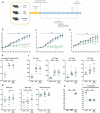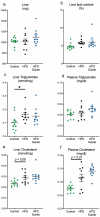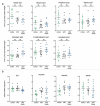From correlation to causality: the case of Subdoligranulum
- PMID: 33323004
- PMCID: PMC7744154
- DOI: 10.1080/19490976.2020.1849998
From correlation to causality: the case of Subdoligranulum
Abstract
Gut microbes are considered as major factors contributing to human health. Nowadays, the vast majority of the data available in the literature are mostly exhibiting negative or positive correlations between specific bacteria and metabolic parameters. From these observations, putative detrimental or beneficial effects are then inferred. Akkermansia muciniphila is one of the unique examples for which the correlations with health benefits have been causally validated in vivo in rodents and humans. In this study, based on available metagenomic data in overweight/obese population and clinical variables that we obtained from two cohorts of individuals (n = 108) we identified several metagenomic species (MGS) strongly associated with A. muciniphila with one standing out: Subdoligranulum. By analyzing both qPCR and shotgun metagenomic data, we discovered that the abundance of Subdoligranulum was correlated positively with microbial richness and HDL-cholesterol levels and negatively correlated with fat mass, adipocyte diameter, insulin resistance, levels of leptin, insulin, CRP, and IL6 in humans. Therefore, to further explore whether these strong correlations could be translated into causation, we investigated the effects of the unique cultivated strain of Subdoligranulum (Subdoligranulum variabile DSM 15176 T) in obese and diabetic mice as a proof-of-concept. Strikingly, there were no significant difference in any of the hallmarks of obesity and diabetes measured (e.g., body weight gain, fat mass gain, glucose tolerance, liver weight, plasma lipids) at the end of the 8 weeks of treatment. Therefore, the absence of effect following the supplementation with S. variabile indicates that increasing the intestinal abundance of this bacterium is not translated into beneficial effects in mice. In conclusion, we demonstrated that despite the fact that numerous strong correlations exist between a given bacteria and health, proof-of-concept experiments are required to be further validated or not in vivo. Hence, an urgent need for causality studies is warranted to move from human observations to preclinical validations.
Keywords: Akkermansia muciniphila; Subdoligranulum; subdoligranulum variabile; high-fat diet; human cohort; mice; obesity.
Figures





References
-
- Cani PD, Van Hul M, Lefort C, Depommier C, Rastelli M, Everard A. Microbial regulation of organismal energy homeostasis. Nature Metabolism. 2019;1:34–46. - PubMed
-
- Aron-Wisnewsky J, Vigliotti C, Witjes J, Le P, Holleboom AG, Verheij J, et al. Gut microbiota and human NAFLD: disentangling microbial signatures from metabolic disorders. Nat Rev Gastroenterol Hepatol. 2020;17:279–297. - PubMed
Publication types
MeSH terms
Substances
Supplementary concepts
LinkOut - more resources
Full Text Sources
Other Literature Sources
Medical
Molecular Biology Databases
Research Materials
Miscellaneous
